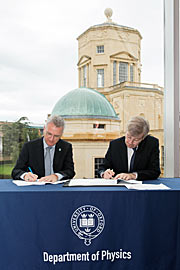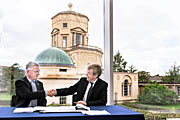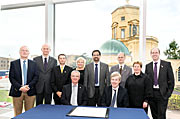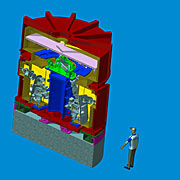Annonce
Agreement Signed for E-ELT HARMONI Instrument
23 septembre 2015
ESO has signed an agreement with an international consortium of institutes [1] for the design and construction of the HARMONI instrument for the European Extremely Large Telescope (E-ELT).
The agreement was signed by Grahame Blair, Executive Director of Programmes, Science and Technology Facilities Council, on behalf of the consortium, and Tim de Zeeuw, ESO Director General, at a ceremony at the Mathematical Institute, University of Oxford, United Kingdom, on 22 September 2015.
Patrick Roche, President of ESO Council and Niranjan Thatte, Principal Investigator for HARMONI, were also in attendance.
HARMONI, or the High Angular Resolution Monolithic Optical and Near-infrared Integral field spectrograph, will be one of the first-light instruments installed on the giant telescope and will function as the workhorse instrument for visible light and near-infrared spectroscopy in the wavelength range 0.5–2.4 µm. It can work with different adaptive optics systems, or even without adaptive optics at all, and will complement the MICADO camera, which is primarily focused on imaging.
HARMONI is an integral field spectrograph that allows more than 30 000 spectra of an astronomical object to be obtained at the same time at near-infrared or visible wavelengths. The design of the instrument is such that it will be easy to calibrate and operate, providing the E-ELT with a "point-and-shoot" spectroscopic instrument ideally suited to fully exploit the huge scientific potential of the telescope in its early years.
Thanks to the enormous light-collecting power and spatial resolution of the 39-metre E-ELT, HARMONI will be uniquely placed to explore galaxies in the early Universe, study the constituents of the local Universe and to characterise exoplanets in great detail. It will be a very versatile instrument, providing a range of image scales, resolving powers, fields of view and wavelength ranges — for instance, providing high spectral resolution for bright objects and high sensitivity for dim, distant objects.
HARMONI is the result of extensive earlier development work over many years, both at ESO and in the community. In particular, early E-ELT instrument studies were initiated by Sandro D'Odorico at ESO. HARMONI also continues the well-established tradition of adaptive optics-assisted near-infrared (SINFONI) and visible light (MUSE) integral field spectroscopy at the VLT.
Notes
[1] The HARMONI Consortium consists of: the University of Oxford (UK), the UK Astronomy Technology Centre (UK), the Centre de Recherche Astrophysique de Lyon, France (France), the Laboratoire d'Astrophysique de Marseille (France), the Instituto de Astrofísica de Canarias, Spain (Spain) and the Centro de Astrobiologia (CSIC - INTA) (Spain).
Liens
Contacts
Niranjan Thatte
Principal Investigator of HARMONI
University of Oxford, United Kingdom
E-mail: thatte@astro.ox.ac.uk
Joël Vernet
ESO Project Scientist
ESO
Garching bei München, Germany
Tel: +49 89 3200 6579
E-mail: jvernet@eso.org
Richard Hook
ESO Public Information Officer
Garching bei München, Germany
Tel: +49 89 3200 6655
Cell: +49 151 1537 3591
E-mail: rhook@eso.org
Lucy Stone
Deputy Media Manager
Science and Technology Facilities Council
Rutherford Appleton Laboratory, Didcot, United Kingdom
Tel. +44 1235 445052
E-mail: lucy.stone@stfc.ac.uk
À propos de l'annonce
| Identification: | ann15070 |
Our use of Cookies
We use cookies that are essential for accessing our websites and using our services. We also use cookies to analyse, measure and improve our websites’ performance, to enable content sharing via social media and to display media content hosted on third-party platforms.
ESO Cookies Policy
The European Organisation for Astronomical Research in the Southern Hemisphere (ESO) is the pre-eminent intergovernmental science and technology organisation in astronomy. It carries out an ambitious programme focused on the design, construction and operation of powerful ground-based observing facilities for astronomy.
This Cookies Policy is intended to provide clarity by outlining the cookies used on the ESO public websites, their functions, the options you have for controlling them, and the ways you can contact us for additional details.
What are cookies?
Cookies are small pieces of data stored on your device by websites you visit. They serve various purposes, such as remembering login credentials and preferences and enhance your browsing experience.
Categories of cookies we use
Essential cookies (always active): These cookies are strictly necessary for the proper functioning of our website. Without these cookies, the website cannot operate correctly, and certain services, such as logging in or accessing secure areas, may not be available; because they are essential for the website’s operation, they cannot be disabled.
Functional Cookies: These cookies enhance your browsing experience by enabling additional features and personalization, such as remembering your preferences and settings. While not strictly necessary for the website to function, they improve usability and convenience; these cookies are only placed if you provide your consent.
Analytics cookies: These cookies collect information about how visitors interact with our website, such as which pages are visited most often and how users navigate the site. This data helps us improve website performance, optimize content, and enhance the user experience; these cookies are only placed if you provide your consent. We use the following analytics cookies.
Matomo Cookies:
This website uses Matomo (formerly Piwik), an open source software which enables the statistical analysis of website visits. Matomo uses cookies (text files) which are saved on your computer and which allow us to analyze how you use our website. The website user information generated by the cookies will only be saved on the servers of our IT Department. We use this information to analyze www.eso.org visits and to prepare reports on website activities. These data will not be disclosed to third parties.
On behalf of ESO, Matomo will use this information for the purpose of evaluating your use of the website, compiling reports on website activity and providing other services relating to website activity and internet usage.
Matomo cookies settings:
Additional Third-party cookies on ESO websites: some of our pages display content from external providers, e.g. YouTube.
Such third-party services are outside of ESO control and may, at any time, change their terms of service, use of cookies, etc.
YouTube: Some videos on the ESO website are embedded from ESO’s official YouTube channel. We have enabled YouTube’s privacy-enhanced mode, meaning that no cookies are set unless the user actively clicks on the video to play it. Additionally, in this mode, YouTube does not store any personally identifiable cookie data for embedded video playbacks. For more details, please refer to YouTube’s embedding videos information page.
Cookies can also be classified based on the following elements.
Regarding the domain, there are:
- First-party cookies, set by the website you are currently visiting. They are stored by the same domain that you are browsing and are used to enhance your experience on that site;
- Third-party cookies, set by a domain other than the one you are currently visiting.
As for their duration, cookies can be:
- Browser-session cookies, which are deleted when the user closes the browser;
- Stored cookies, which stay on the user's device for a predetermined period of time.
How to manage cookies
Cookie settings: You can modify your cookie choices for the ESO webpages at any time by clicking on the link Cookie settings at the bottom of any page.
In your browser: If you wish to delete cookies or instruct your browser to delete or block cookies by default, please visit the help pages of your browser:
Please be aware that if you delete or decline cookies, certain functionalities of our website may be not be available and your browsing experience may be affected.
You can set most browsers to prevent any cookies being placed on your device, but you may then have to manually adjust some preferences every time you visit a site/page. And some services and functionalities may not work properly at all (e.g. profile logging-in, shop check out).
Updates to the ESO Cookies Policy
The ESO Cookies Policy may be subject to future updates, which will be made available on this page.
Additional information
For any queries related to cookies, please contact: pdprATesoDOTorg.
As ESO public webpages are managed by our Department of Communication, your questions will be dealt with the support of the said Department.





